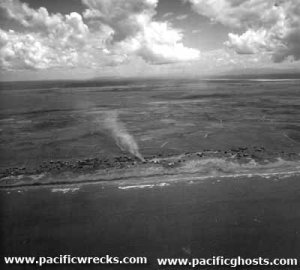![]() The Pacific War Online Encyclopedia
The Pacific War Online Encyclopedia
|
| Previous: Aoyama Kiyoshi | Table of Contents | Next: APc Class, U.S. Coastal Transports |

U.S. Air Force. Via pacificwrecks.com
Aparri (121.661E
18.317N) is a port on the northern coast of Luzon, near the mouth of the Cagayan
River. In 1941,
it had a population of 26,500 and some modest port
facilities. It is surrounded by mountains and was accessible in 1941 only by a coastal road or through the Balete Pass to the south.
First Luzon Campaign. Aparri was the target of the First Surprise Attack Force on 10 December 1941, which landed 2000 men of the Tanaka Detachment. There was no opposition from the company of 12 Regiment, 11 Philippine Division in the area, which ignored an order to counterattack and immediately withdrew south, and the Japanese found themselves hindered more by heavy surf than the enemy. Only two companies were landed before the transports were forced to move twenty miles east to land the remaining forces. An American air raid destroyed W-19, but with no meaningful ground opposition the Japanese quickly secured the nearby airstrip, at Camalaniugan (121.688E 18.264N). This proved unsuitable for light bombers, making the whole landing operation pointless.
Wainright concluded that any attempt by the
Japanese to move south from Aparri could be easily blocked at Balete
Pass, and so he declined to divert any further troops to the area.
Second Luzon Campaign. Plans were
considered to take Aparri early in the second Luzon campaign, but the
operation was ruled unnecessary due to the effectiveness of American carrier aircraft. On 1 June 1945, after 103 Division abandoned Aparri, the town was reoccupied by a scratch force of Rangers, other American troops, and Filippino guerrillas
(Connolly Force).
Fearing that Conolly Force was too weak to hold the
coastal road back to Lingayen Gulf, and desiring to push south to Tuguegarao, Krueger ordered a force of 994 American paratroops of 511 Parachute Regiment to drop on the airfield on 23 June 1945. The force was accompanied by six Waco gliders and one CG-13 glider carrying jeeps and artillery pieces.
Although the airfield had already been secured by Connolly Force and so
the landings were unopposed, a 25 mph (30 km/h) wind across the
airfield resulted in 7% jump casualties.
References
The Pacific War Online Encyclopedia © 2007, 2011-2012 by Kent G. Budge. Index